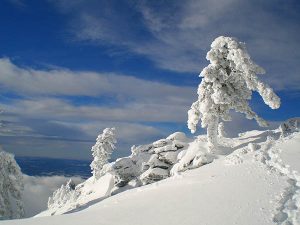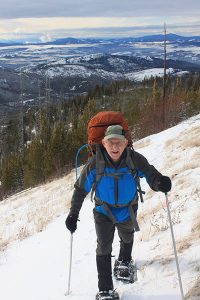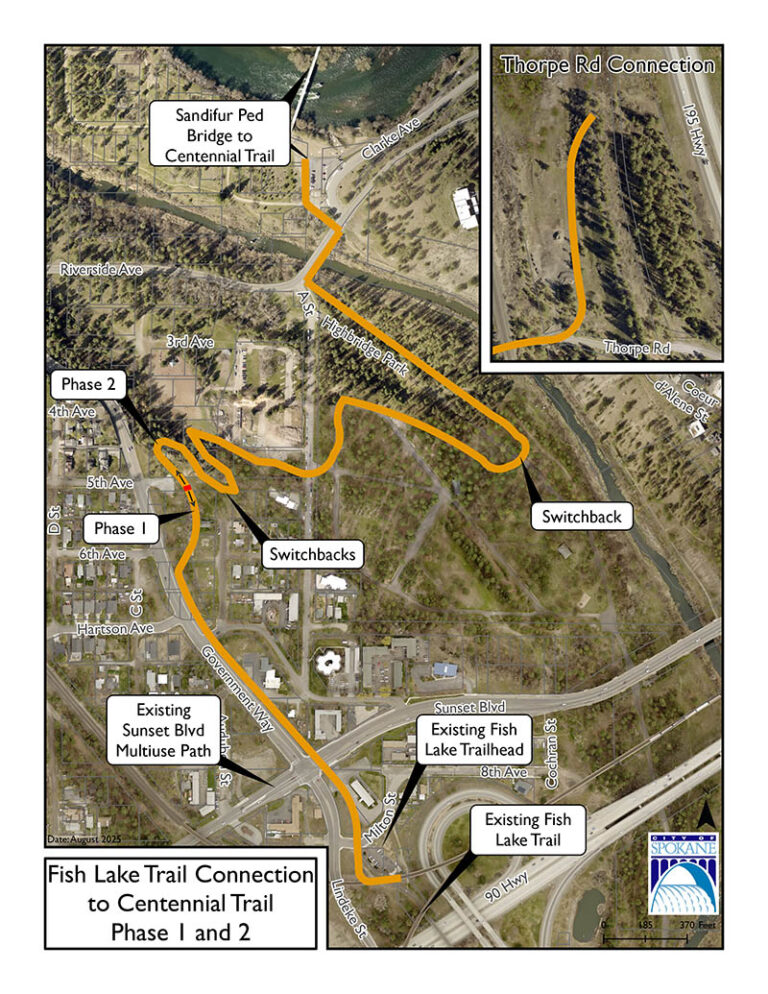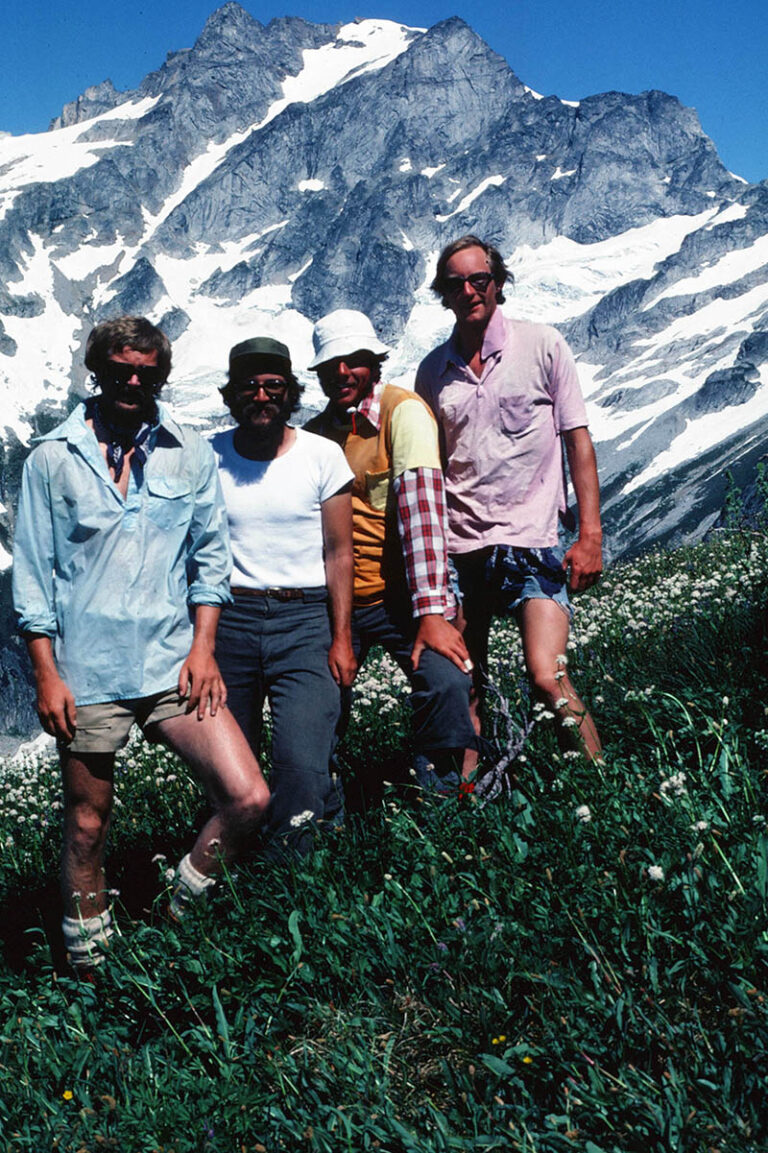It’s no wonder that snowshoeing is the fastest growing winter sport. As one snowshoe joke puts it, anyone can learn how to do it in 10 easy steps: Put on snowshoes and take 10 steps. Now you’re an expert!
It may only take 10 steps to master, but there are several safety concerns that accompany snowshoe outings, the most important of which is a basic understanding of avalanche danger. Several local snowshoe locations are free from risk of avalanche, but there are some hikes that shouldn’t be attempted when avalanche danger is moderate or high. Hikers should also carry the 13 essentials and realize that the consequences of being ill-prepared can be severe in winter. With a little advance planning and the flexibility to modify plans based on group ability or changing weather conditions, there are many snowshoe destinations within a day’s drive throughout the Inland Northwest.
Spokane County Parks’ Conservation Futures properties are promising introductory snowshoe destinations. You won’t find any avalanche danger in these close-to-town locations. The downside is that during some winters, you also won’t find much snow. That makes getting to the trailhead easy but may require visitors to carry their snowshoes for part of the hike. McKenzie Conservation Area (located on West Newman Lake Drive) can be a winter wonderland, or it can be a bare ground hike. Either way, it’s a lovely mid-winter visit; just know that sometimes Old Man Winter doesn’t cooperate at that elevation. McKenzie Conservation Area provides a good beginner snowshoe hike, with its well-marked trail system and short loop options. I like to start on Bedrock Ridge, then connect to Turtle Rock, forming a 3.3-mile loop that includes opportunities for wildlife watching and lake views.

If you’re looking for a more challenging hike, try Canfield Gulch at Antoine Peak Conservation Area (located on E. Lincoln Road off Campbell Road in Spokane Valley). The trail starts low, which means visitors may need to carry snowshoes at first. The trail system is not well-marked, so visit the Spokane County Parks website to print a map before you go. It’s good to practice route finding at a close-to-town location before venturing farther afield. On a good snow year, Antoine is the perfect place to squeeze in a short out-and-back on the way home from work, or to test one’s fitness with its long climb to the summit. The views from the top make the effort well worth it.
Mount Spokane has the best local trail system where you’re guaranteed to need your snowshoes. Of the eight named peaks within the park, four are located within the snowshoe trail system and can be climbed in one strenuous hike. Start from the upper Sno-Park lot (Sno-Park pass required) and ascend Trail 131 to Bald Knob. Cross the groomed snowmobile trail and continue across Trail 130 to the CCC cabin at Beauty Mountain, the first and easiest summit. Then descend to Saddle Junction on the Kit Carson Loop Road before climbing Trail 160 to Mount Kit Carson. After admiring the view from this summit, hike north on Trail 130 to connect to Day Mountain, then continue down Trail 130 to rejoin the Kit Carson Loop Road. Turn right to return to Saddle Junction, keeping to the side of the trail on this section, which is shared with snowmobiles, then turn left to climb upper 140 to the summit of Mount Spokane. Descend via the snowshoe trail to Bald Knob, located just outside the ski area boundary, then repeat the trail segment on 131 to return to the parking lot. If all four peaks are too much, ease into this grand park tour by saving the Mount Kit Carson and Day Mountain section for another day. Print a free map from mountspokane.org before you go.

Once these snowshoe routes have been mastered, hikers may be ready to try a more challenging outing. The Little Pend Oreille Lakes Sno-Park at Frater Lake near Colville, Wash., is a good place to start. There are shorter trails available near the parking lot, but remember to stay off the groomed Nordic trails if you stay low. A better option is to take the Colville National Forest map and hike Trail 142 to Granite Peak. In three visits, I’ve never actually made the summit, but I love the challenging climb and especially the quick descent. This is the best place to practice breaking trail through potentially deep powder.
Finally, Sherman Peak west of Kettle Falls, Wash., is the sort of hike that’s best appreciated on snowshoes. The Sno-Park access is located at the top of Sherman Pass, and hikers must cross the highway to access the Kettle Crest to begin this hike. It’s crucial that hikers check avalanche reports before attempting this hike following snowstorms. This is the 10th tallest peak in eastern Washington, and the summer trail merely makes a circuit around the mountain. With snow on the ground, it’s easy to make it directly to the top. On a clear day, it’s possible to see the eastern flank of the Cascade Range. Make the ascent from the gentle south side of the peak, avoiding the exposed eastern flank.













